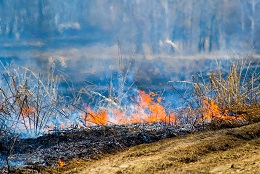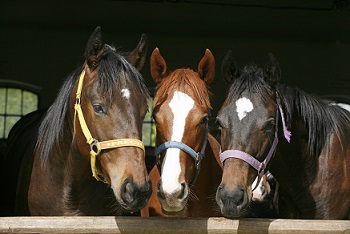 Australia is a place of extreme weather conditions; thousands of people, pets and properties are affected every year by our harsh climate. The word bushfire chills many of us, especially after the horrific Black Saturday and Ash Wednesday bushfires. Many of us have a plan in place with regards to ourselves and even our smaller, household pets, but what can we do to maximise survival and reduce injury to our beloved equines and other larger livestock?
Australia is a place of extreme weather conditions; thousands of people, pets and properties are affected every year by our harsh climate. The word bushfire chills many of us, especially after the horrific Black Saturday and Ash Wednesday bushfires. Many of us have a plan in place with regards to ourselves and even our smaller, household pets, but what can we do to maximise survival and reduce injury to our beloved equines and other larger livestock?
Developing Your Fire Plan
Preventing an Escalation
Reduce fuel sources such as dry dead grass and leaf litter in stable gutters. Ensure fuel sources that you cannot forgo, such as hay and chemicals, are stored away from important buildings and animals.
If possible, install rainwater tanks, for two reasons. Firstly you will have a ready supply of water to combat fires (ensure now that hoses are long enough and fittings are correct). Secondly, you can use the rainwater to keep lawns and gardens well hydrated, thus reducing the amount of dry/dead grass which could act as fuel. Consider that steel tanks will be less likely to melt than plastic ones.
Ensure your plans are still viable in the event of electrical power loss. A dam at the end of a paddock is not particularly useful as a fire fighting water resource if you cannot pump water up because the pump won’t work.
Make sure you’ve got the bare essentials of fire-fighting tools. These may include, but are not limited to:
- Gardens hoses that are at least 25-30m long, and preferably connected to a water source at all times. Fittings would preferably be metal rather than plastic.
- A long ladder to reach building tops
- Shovels (not plastic)
- Rakes (not plastic)
- Fire extinguishers
- Wool blankets
- Buckets (not plastic)
- Compressor to make pumps work in power outages
If your equines were to escape, it is a good idea to have them identifiable. The first thing to do in preparation is to have them all microchipped. Once microchipped, ensure you have their number recorded with as many different registries as possible. Also make sure you give your vet a call and give them the numbers. For more on microchipping, see our article.
Have some livestock grease crayons on hand – if the fire danger is high, you can write you name, mobile number and other important details on them in case your horses do get loose so they can hopefully be returned quicker.
It may be a good idea to have a halter on them with your details written on/attached, and a short (say 30cm or so) lead attached also, and it is best if there are no metal buckles on it which could burn. Whilst there is a risk that they could get caught on a fence, you must weight this up with the risk that they may not be caught if they are panicked. If you do decide to keep a halter/lead on ensure it is not made of a synthetic material: leather or cotton webbing is best.
 Register your horses under your PIC (Property Identification Code) with the DPI - 13 25 23. Also consider registering with the Australian Horse Industry Council Emergency Contact Database here.
Register your horses under your PIC (Property Identification Code) with the DPI - 13 25 23. Also consider registering with the Australian Horse Industry Council Emergency Contact Database here.
Leave or Stay?
To leave or stay is one of the biggest questions many ask, and opinions are certainly varied on the matter. We certainly cannot advise you one way or the other, but we can suggest a few options for your consideration. Your decision may be based on your property situation, personal situation and transport options. You may wish to consult the local SES or fire brigade for advice NOW, before an emergency arises.
Whatever you decide, make sure everyone knows what the plan is, including those who are in care of your pets if you are going away (of course depending on if it is safe for them to get to your place). Have a copy stuck up in your home, stable &/or feed shed – really, in as many places as possible, so in a stressful situation it’s easy to find and remind everyone of what they need to be doing. Hold practice fire drills so everyone is familiar with the motions of the plan.
If agisting, work with your agistment property owner to have a plan in place and try and get all other agisters to know what it is, as fires may break out when any one of you is there.
If Leaving…
If you are planning to evacuate, make sure everyone knows your plan! If it looks like bushfires are about and you plan to evacuate, always do so early. You choice of evacuation property may be local showgrounds, pony clubs, friends, or an agistment property. Make sure you’ve arranged everything beforehand, and you are aware of the property’s suitability in the bushfire season.
If possible, design several escape routes from your property. You may wish to decide these in conjunction with a fire authority such as the SES, to determine the safest routes given your locality.
Remember, even if you do plan on evacuating, there are some circumstances which may prevent you getting away, so it is always a good idea to have a plan in the event you and or your horses cannot leave the property.
Consider whether you can transport all of your horses: if you have to take some/leave some, which ones? As awful as this may be to think about, it is best that everyone knows so precious time is not wasted in deciding. Practice floating so it is a smoother process. For more on safe floating practices, see here.
If you plan to stay or are unable to safely evacuate…
Ensure you have a designated ‘safe’ paddock. Ideally this would be the largest paddock on the property, so that your horses have a greater chance of getting away from the flames. You may make this ‘safe’ paddock bigger by opening gates to allow access between other paddocks. It is a good idea to walk your horses around the safe paddock/s so that they are familiar with the general layout, especially so that they know where gates are if you are joining paddocks.
It is best if the safe paddock has a dam, or you could use a paddock with a fenced sand arena, as it could be harder for flames to reach them in the centre (though in more serious fires this may not be the case).
Fire Kits
There are many fire kits on the net that relate to your human family, but what should you keep on hand for your horses?
- Lead rope and halter
- Towels
- Torch & spare batteries
- Wire cutters & perhaps a knife
- Equine first aid kit
- Water buckets
- Battery operated radio
When Fire strikes…
Remain calm, listen to your battery operated radios for weather conditions & instructions. Try and obey fire authorities as they sincerely have your best interests at heart.
Have reserve water bodies in place – fill as many buckets, baths, troughs etc as possible.
Move your horses into the designated safe paddocks, or prepare them if you are planning to evacuate. In either situation remove all rugs, especially any synthetic gear, and if possible hose your horses down as this may reduce the risk of minor burns.
As we all know, horses are amazingly intelligent creatures, and if given the space have been known to escape serious injury by moving around the flames and through smaller fires to avoid death. Remembering this, never put yourself at risk, if they are given the space of a large paddock hopefully they can make it through the worst. Also, in saying this, never turn them out onto the road if you are wishing for them to have more space – they are just as likely to be burned and also may cause a terrible accident as many drivers will be frantic on the roads.
The main fire front will usually take 10 to 20 minutes to pass depending on environment.
The Aftermath…
Put out any spot fires. Then inspect your animals to assess the severity of their injury. If fire has passed close always seek immediate veterinary attention, even if burns are not visible, as the respiratory difficulties from smoke inhalation can take time to present.
Ask your vet for advice on treating burns in the time before they arrive. If you cannot reach a vet it may be a good idea to implement cold water therapy (via hosing) , though this is not a complete substitute for veterinary attention.
After the vets visit, be wary of turning you horse back out into a burned paddock: there may be hot spots, unstable trees/powerlines and fencing may not be secure.
We truly hope none of you ever have to use the information we’ve provided in this article, but ignoring safety precautions and preparation could result in the worst. Nobody wishes to see such devastation to both human and animal life as has been witnessed in Australia’s past.
We have developed a fire safety checklist for you to print out - included are important numbers relevant in bushfire emergencies.
Bushfire Safety Checklist - Download
Texts Consulted:
Image 1 Source - Image 2 Source









